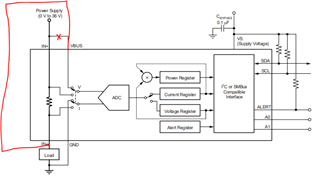Other Parts Discussed in Thread: INA228
Hi expert,
In my application, the DCDC output voltage is 0.75V and the max current is around 10A. I would like to measure the DCDC output voltage and current. The DCDC output is connected to IN+ pins and the load circuit is connected to IN- pins. In the datasheet, the VBUS pin is connected to IN+ and the measured voltage is actually on the IN+ (before the power monitor). But I want to measure the voltage on IN-, because when the output current goes to as high as 10A, the voltage drop on the power monitor could reach ~45mV (according to datasheet, the package resistance between IN+ and IN- is 4.5mOh) - this voltage drop can't be ignored comparing to 750mV output voltage.
So, I want to connect the VBUS pin to IN- instead of IN+ pin and sense the voltage after the power monitor, as the below picture showing. And then the measured voltage value is close to the real value on the load.

Could you please kindly let me know if this usage is supported? Thank you in advance!
Best regards,
Shaoyuan Zheng

